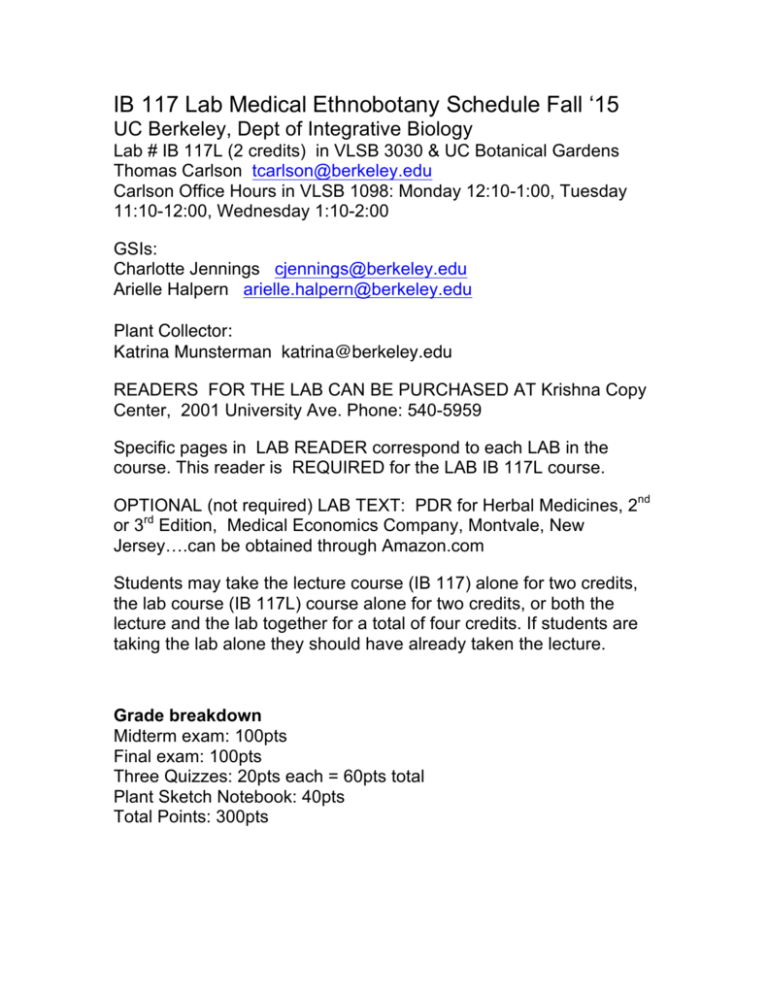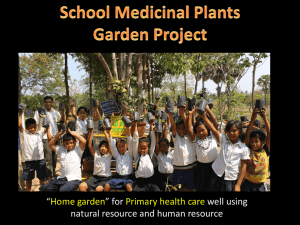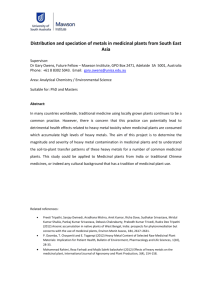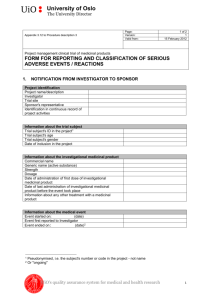IB 117 Lab - Integrative Biology
advertisement

IB 117 Lab Medical Ethnobotany Schedule Fall ‘15 UC Berkeley, Dept of Integrative Biology Lab # IB 117L (2 credits) in VLSB 3030 & UC Botanical Gardens Thomas Carlson tcarlson@berkeley.edu Carlson Office Hours in VLSB 1098: Monday 12:10-1:00, Tuesday 11:10-12:00, Wednesday 1:10-2:00 GSIs: Charlotte Jennings cjennings@berkeley.edu Arielle Halpern arielle.halpern@berkeley.edu Plant Collector: Katrina Munsterman katrina@berkeley.edu READERS FOR THE LAB CAN BE PURCHASED AT Krishna Copy Center, 2001 University Ave. Phone: 540-5959 Specific pages in LAB READER correspond to each LAB in the course. This reader is REQUIRED for the LAB IB 117L course. OPTIONAL (not required) LAB TEXT: PDR for Herbal Medicines, 2nd or 3rd Edition, Medical Economics Company, Montvale, New Jersey….can be obtained through Amazon.com Students may take the lecture course (IB 117) alone for two credits, the lab course (IB 117L) course alone for two credits, or both the lecture and the lab together for a total of four credits. If students are taking the lab alone they should have already taken the lecture. Grade breakdown Midterm exam: 100pts Final exam: 100pts Three Quizzes: 20pts each = 60pts total Plant Sketch Notebook: 40pts Total Points: 300pts IB 117L MEDICAL ETHNOBOTANY LAB The laboratory portion of the course (IB 117L) will be for 2 credits held in the Valley Life Sciences Building and the UC Botanical Gardens. These labs will focus on studying medicinal plants from the major ecosystems and geographical regions of the world. Students will learn common names, scientific names, plant families, field identification, habitats, and ethnomedical uses of medicinal plants. How the medicinal plant is prepared, administered, and used as a phytomedicine will also be discussed. There will be reference to the phylogenetic relationships between the plant families and genera represented by the medicinal plants. The course will have a teaching laboratory room in Valley Life Sciences Building where fresh botanical specimens and dried botanical voucher specimens of the medicinal plant species will be displayed for students to study throughout each week. Students will also have weekly outdoor labs at the UC Botanical Gardens. Lab logistics You must come to ALL of the labs on time. There is a lab on Tuesday and Thursday. During most weeks, one of the days the lab will meet in 3097/3095 VLSB, and the other day at the UC Berkeley Botanic Gardens. Attendance is required for both lab days. There will be a discussion/lecture at the beginning and we will go over lab material as a group (and have quizzes), One the first day of lab, all students should meet in VLSB 3030. Objectives 1- Identify plants by their family, genus and specific epithet, in addition to their common name and ethnomedical uses 2- Know geographical origin of each plant (i.e. Asia, Europe, America, Africa, Australia, Pacific Islands) 3- Learn about medicinal plant extraction techniques Required Plant Sketch Notebooks Students are required to make sketches of all the required plants. There will be around 220 plant species required for the course. Each student will need to purchase a bound notebook for taking notes and making drawings of all these plants. Students should bring drawing materials e.g., colored pencils, regular pencils to each lab. Materials needed 1) Lab reader (Krishna Copy at 2001 University Ave) 2) Sketch Notebook—making drawings and taking notes on required plants 3) Drawing materials—colored pencils, regular pencils, straightedge/ruler, etc. Labs: Tuesdays & Thursdays: Section 1 (9-12:00) and Section 2 (2-5:00) in VLSB 3030 & UC Botanical Gardens Week #1: 8/27: NO LAB Week #2: 9/1, 9/3: Introduction to plant vegetative morphology, reproductive parts and fruits Alcohol extraction of medicinal plants. Water decoction of common herbs Week #3: 9/8, 9/10: California/USA/Canada (Aceraceae – Lamiaceae) Week #4: 9/15, 9/17: California/USA/Canada (Lauraceae – Zygophyllaaceae) Week #5: 9/22, 9/24: Europe/Mediterranean/Near East (Berberidaceae – Lauraceae) Weeks #6: 9/29, 10/1: Europe/Mediterranean/Near East (Apiaceae –Asteraceae) Week #7: 10/6: California ethnobotany lecture in VLSB 3030: 10/8: Decant alcohol extractions Week #8: 10/13, 10/15: Europe/Mediterranean/Near East (Liliaceae –Vitaceae) Weeks #9: 10/20: Herbal salves, herbal compresses, lip balm 10/22: VLSB 3030, MIDTERM EXAM Weeks #10: 10/27, 10/29: Asia (Apiaceae – Myrtaceae) Week #11: 11/3, 11/5 : Asia (Nelumbonaceae – Zingiberaceaeaceae) Week #12: 11/10, 11/12: Australia and Africa Week #13: 11/17, 11/19: Tropical America (Agavaceae – Euphorbiaceae) Week #14: 11/24: Tropical America (Fabaceae – Tropaeolaceae) in VLSB 3030 11/26: Thanksgiving break: no lab Week #15: 12/1: VLSB 3030, Review session 12/3: VLSB 3030, IB 117 LAB FINAL EXAM TABLE OF CONTENT FOR IB 117 LAB READER General Subject Categories: UC Botanical Garden Maps: pages 1-11 Introduction to Plant Morphology & Reproductive Parts Lab: pages 13-28 European Plant Labs: pages 5-6, 77-104, 58-68 Asian Plant Labs: pages 7-8, 124-139, 53-57 California, North American Plant Labs: pages 9-10, 105-123, 49-52 Africa, Australia Plant Labs: pages 140-145 Tropical America Plant Labs: pages 11, 146-157 Herbalism/Medicinal Plant Preparation Labs: pages 158-170 IB 117 Lab Reader Content by pages: Pages 1-4: Maps of Botanical Gardens Pages 5-6: Botanical Garden Map: Europe, Mediterranean, Near East Medicinal Plants Pages 7-8: Botanical Garden Map: Asian Medicinal Plants Pages 9-10: Botanical Garden Map: California & North America Medicinal Plants Page 11: Botanical Garden Map: California & North America Medicinal Plants Page 13: Botanical Terminology and Outline of How to Evaluate Plants Pages 15-20: Leaves Pages 21-23: Fruits & Seeds Pages 25-28: Flowers Pages 29-48: Jepson manual Glossary of Plants Pages 49-52: California Natives: Plants & People: A Self Guided Tour at UC Bot Garden Pages 53-57: The Chinese Medicinal Garden at UC Botanical Garden Pages 58-68: Darwinian Gastronomy: Why we use Spices Page 69: Phytochemical Profile Pages 70-71: Human Disease Terminology Pages 72-73: Important Plant Families Pages 74-76: Common Names of Plant Families Pages 77-78: Europe, Mediterranean, Near East Medicinal Plant List Pages 79-104: Europe, Mediterranean, Near East Medicinal Plant Names and Uses Pages 105-106: California & North America Medicinal Plant List Pages 107-123: California & North America Medicinal Plant Names and Uses Pages 124-125: Asian & Pacific Island Medicinal Plant List Pages 126-139: Asian & Pacific Island Medicinal Plant Names and Uses Page 140: Africa & Australian Plant List Pages 141: Australian Medicinal Plant Names and Uses Pages 142-145: African Medicinal Plant Names and Uses Page 146: Tropical America Medicinal Plant List Pages 147-157: Tropical America Medicinal Plant Names and Uses Page 158: Chemical Classes in Plants Pages 159-166: Preparation of Plant-Based Medicines Pages 167-168: Herbal Preparations Pages 169-170: Botanical Extraction Methods in Natural Product Chemistry






